Hydrangea pink room. All about the beauty of hydrangeas in home cultivation.
Hydrangea, by and large, - garden flower, but it is also possible to grow it at home. The flower itself grows in open ground and for the winter less winter-hardy varieties transplanted into pots and left there until the end of cold weather. There are a total of about 80 varieties of hydrangea, in appearance it happens:
- paniculate;
- treelike;
- anabel;
- large-leaved;
- pink;
- petiolate.
Large-leaved hydrangea is the most thermophilic species
Large-leaved hydrangea is the most thermophilic species of all types of hydrangea; earlier it was more adapted to planting in room conditions, but through the efforts of breeders, more frost-resistant varieties were bred.
motherland large-leaved hydrangea is China. In the subtropics, this plant in growth reaches about 4 m, but the closer to the north, the more it decreases in growth to 1 m.
The size of the flower in diameter is about 3 cm, the inflorescences themselves reach a diameter of up to 15 cm. The plant blooms in July. New varieties have flowers not only pink, but also blue, and white color.
At room hydrangea planting and care conditions require thorough. First of all, decide on a place, you need to put it where there will be partial shade, although the plant is photophilous, it is better to avoid direct rays.

Direct rays should be avoided
However, you should not put it in a place that is too shaded, as the plant will begin to bloom later, and the flowering itself will not be plentiful. The best place there will be one where the base of the flower will be in the shade, and the top in the sun.
The soil
The color of the hydrangea depends on the soil, whether you plant it indoors or outdoors. Hydrangea loves acidic soil, the more acidity, the darker the color.
For example, in neutral soil, the flower will be pink or white, if the acidity is greater, then the color becomes blue or purple, so many gardeners consider it their duty to experiment in changing colors.
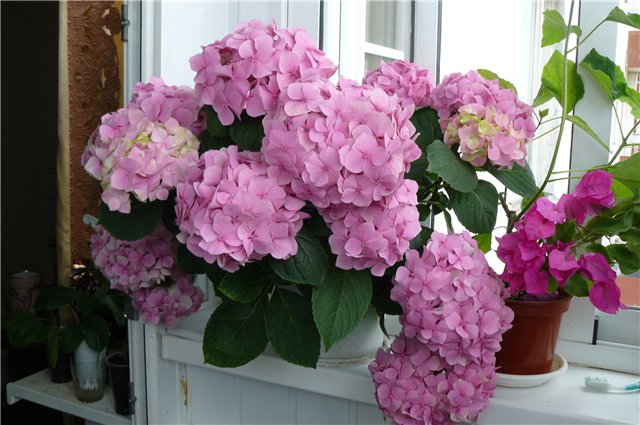
Hydrangea loves acidic soil
The flower itself loves acidic soils with a pH of 4 to 5.5. Therefore, if you decide to plant a hydrangea, you will not just take any land that you want. For it, you need to follow certain proportions if you want your flower to develop well and have a beautiful color.
Planting, reproduction, transplant
To propagate room hydrangea, the cutting method is used. This easy way and efficient. We take cuttings from non-flowering basal shoots, each must have several pairs of fresh leaves, plant them in a soil mixture consisting of sand and peat, or, if there is no peat, you can use plain sand.
If possible, before planting, treat the roots with a special solution that will help to take root faster. Rooting cuttings takes about 20 days, but do not expect flowering this year, it will only be in the second year.
If you bought a hydrangea in a store, in this case you need to take a more spacious pot and transfer the flower to the already prepared soil. After that, you need to water the flower abundantly and spray.
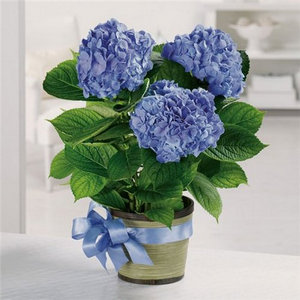
It is necessary to water the flower abundantly and spray
Don't forget that be a hydrangea though indoor flower, even growing in the garden, it needs moisture. No need to overmoisten, try to maintain uniform humidity, in which case your flower will grow and develop perfectly.
When transplanting a plant, keep in mind that you can not transplant it into garden humus, but the worst option can be a mixture of garden humus and a ready-made hydrangea soil mixture, in which case you will get soil that is "indigestible" by the plant.
For transplanting room hydrangea, we take pots with a diameter of 8–9 cm, for young seedlings this is a normal pot. After the plant gets stronger and grows a little, it will already be possible to transfer it to a pot with a large diameter.
When transplanting, we need an earth mixture in relation to three parts of sod land, three parts of leafy soil, one part of sand.
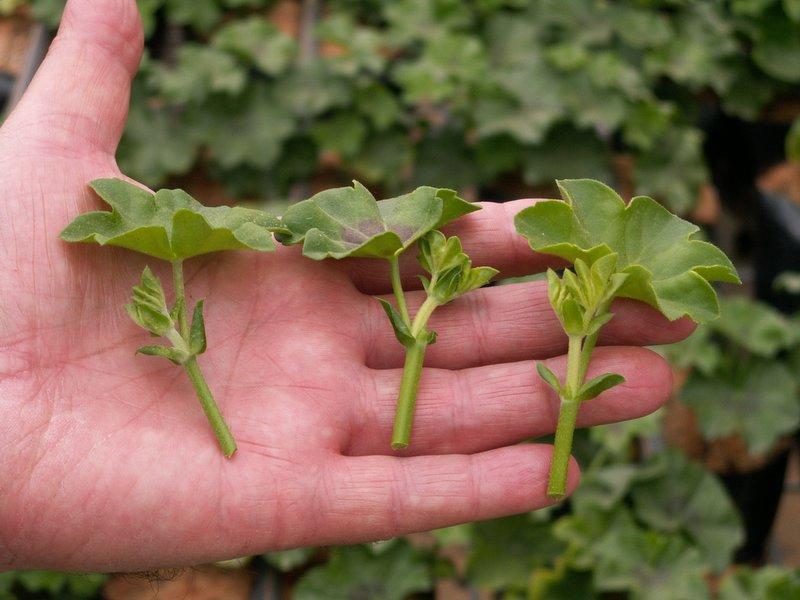
young seedlings
If you are transplanting mature plant, then take in equal proportion coniferous land and peat, as well as half of the sand and humus, so we get the scheme 1:1:0.5:0.5.
It is best to transplant in April. We take a pot of the required size, make drainage, lay a layer of peat moss on top, preferably chopped. We transplant the flower to the required earth mixture, leaving the root collar on the surface, but in such a way that it does not rise too high above the ground.
After transplanting, the ground around the flower must be pressed a little, this can be done with a stick or hands, the sides of the pot must be free so that during watering the water does not overflow over them.
We water, spray and remove the pot for a while in a room where there are no drafts, direct sun rays. Try to keep the temperature between 18-22 degrees.
Repot the plant every year, but before flowering.
Hydrangea care indoors
How to care for room hydrangea? The question is relevant and relevant at all times, since many novice gardeners have big problems due to ignorance of the flower and its properties.
Many are surprised by the change in color - there was one, and then it became another. Do not be alarmed, as mentioned above, it all depends on the pH level of the soil, that is, on its acidity. But not all species can change color, our large-leaved is most suitable for such experiments. But the tree-like, no matter what you do, will not change its color, what color is determined by nature, it will be so.
For a room is extremely important, since it moisture-loving plant, and if left unattended, the flower will die. It requires frequent and plentiful watering, but you do not need to heavily flood the plant.
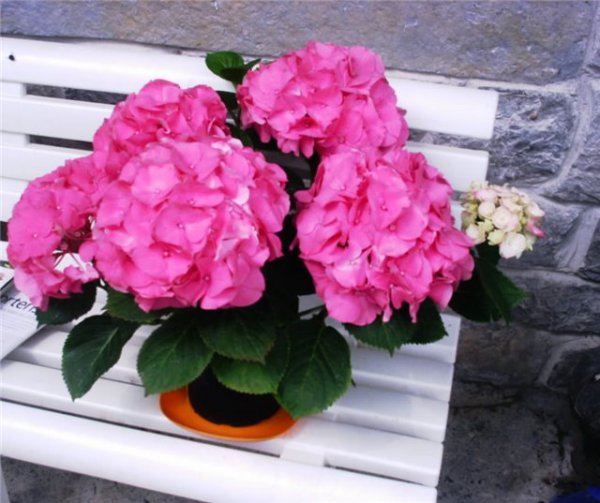
It requires frequent and plentiful watering, but you do not need to heavily flood the plant.
Hydrangea can tolerate a little dryness of the soil, but if the earthen ball is completely dry, the flower will dry out. It is recommended to water with soft water, since hard water adversely affects the plant. Spray it periodically.
In addition to watering, also follow the lighting, you do not need direct rays, but you should not keep it in the shade either, it is desirable that the top of the flower is well lit and the lower part remains in partial shade.
Maintain room temperature, preferably 18 or 20 degrees, but for a dormant flower, a cooler room of 6-8 degrees is needed.
It is advised to put a flower pot at a distance of 3 meters from the window, so it will not feel too much temperature difference and there will be no strong exposure to sunlight.
What is the "dormant hydrangea"?
For many, it is a mystery what a hydrangea's state of rest is. This is the rest period after the flowering of the plant. It usually blooms from spring to late autumn. After that, in winter time, she enters a state of rest, which lasts approximately 70-80 days.
During this period, the hydrangea is watered less, after the leaves fall, it is removed for wintering in a dark, cool room, it may be glazed loggia, pantry. Old flowers must be cut from the plant.
In the spring, the hydrangea is brought into an ordinary room, then all weakened branches are cut off, and strong stems will sprout. After pruning, the plant does not need to be fed.
Feeding
Feeding should be carried out once a week, they are fed with complex mineral fertilizers, they are diluted in the ratio: 2 grams of fertilizer per 1 liter of water.
If you want your flower to be blue or blue, then feed it twice a month with alum and iron salts.

If you want your flower to be blue or blue, then feed it with alum and iron salts.
You can conduct such an experiment: add iron salt on one side of the plant, do not feed the other side. Due to this, your plant will bloom on one bush different colors: on the side where top dressing was done, the color will turn blue, on the other, where nothing was added, pink.
Diseases
Hydrangeas are often attacked by aphids and spider mite. To get rid of aphids, make a soap solution and treat the plant with it. If this does not help, then apply karbofos or actellik.
To get rid of the hydrangea from the spider mite, it is necessary to moisten the air, that is, spray the flower periodically warm water. In case of severe damage, the plant must be treated with actellik or akarin.
- Stem nematode - there is only one way to fight - the destruction of a diseased plant. Symptoms: loss of decorative effect. Damage sites: flowers, leaves, stem.
- Powdery mildew - feed with phosphorus, or potash fertilizers they develop resistance to this disease. Symptoms: white spots appear on the leaves, giving the impression of powder, they turn brown over time.
- Ring spot - do not allow the development of this disease, as it completely destroys the entire flower. Symptoms: round bright spots, after which the leaf deteriorates and the flowers become smaller, over time the plant stops blooming altogether.
- Gray rot - large wet spots, they cover the surface of the leaf, peduncles, buds, stem. Remove spoiled leaves, process the plant Bordeaux mixture. This disease is also not recommended to be started, and at the first appearance, start treating the flower.
Popular varieties of large-leaved hydrangea
We have already discussed all the nuances of growing hydrangeas, but have not paid attention to the most fine varieties large-leaved flower. These include:
- Hydrangea macrophylla ‘All Summer Beauty’ is a beautiful, delicate flower, bred by American breeders, is one of the newest and most popular varieties, with white and pink flowers.
- Hydrangea macrophylla 'Horwack' - well adapted to color change, versatility in that this variety can grow in 9 climatic zones. The flowers are very beautifully shaped, which cannot but attract attention.
- Hydrangea macrophylla Perfektion - a variety of colors (from white to blue) - the main plus, a perennial plant.
- Hydrangea macrophylla ‘Ramars’ showy, variegated flowers.
Hydrangea or hydrangea is a perennial ornamental flowering plant of the Hortensia family. To date, there are indoor and garden varieties of this flower, presented in the form of shrubs and trees. Indoor hydrangea is smaller in size and blooms with smaller flowers than garden specimens. AT natural conditions this flower can be found on the American continent, as well as in China, Japan and the South East Asia.
Description of room hydrangea
 Indoor hydrangea is an elegant perennial in the form of a shrub. It blooms in large spherical inflorescences with a diameter of thirty-five centimeters. Depending on the variety, the inflorescences are umbrella-shaped, corymbose or racemose. Fertile flowers are located in the center, and barren flowers are located along the edges of the inflorescences. The leaves are large, dark green, egg-shaped and are opposite.
Indoor hydrangea is an elegant perennial in the form of a shrub. It blooms in large spherical inflorescences with a diameter of thirty-five centimeters. Depending on the variety, the inflorescences are umbrella-shaped, corymbose or racemose. Fertile flowers are located in the center, and barren flowers are located along the edges of the inflorescences. The leaves are large, dark green, egg-shaped and are opposite.
The color of the flowers directly depends on the composition and structure of the soil in which indoor hydrangeas grow. In the ground with high level acidity, the flowers have a rich blue color; on neutral soil, hydrangeas bloom white or cream flowers. In alkaline soil, hydrangea inflorescences are colorless faded flowers.
Indoor hydrangea is a fruiting plant. Seeds ripen in a multi-seeded box. If these flowers are given proper care, then plants up to one meter high can be grown. Hydrangea has many beautiful views. The most popular in home floriculture is large-leaved hydrangea, the care of which is quite simple. it decorative perennial with spreading dark green foliage. Large and bright inflorescences form at the tops of the stems.
Rules for the care of home hydrangea
Indoor hydrangea - unpretentious and very beautiful plant. Knowing all the features of the content, everyone can grow this flower. Hydrangea care at home has some features:
illumination
This perennial likes to grow in a well-lit place where there is no scorching sun. It can be placed two meters from the windowsill with south side at home. This is an ideal place for the full growth and lush flowering of the plant.
Under conditions of stable temperature regime, within twenty degrees, where there are no drafts, indoor hydrangea will actively grow. Such a condition is necessary for the flower during the growing season.
In winter, when the plant enters the dormant phase, it is transferred to a cooler place with a temperature of eight to ten degrees. In such conditions, the hydrangea will stay until February, until the growing season begins. As soon as the first buds appear, the flower is transferred to a warm and bright place.
Indoor hydrangea does not tolerate heat well and begins to shed its leaves en masse.
Proper care and right conditions content is the key to abundant and long-term flowering of hydrangeas in the future. If these rules are not followed, indoor hydrangea will bloom only after a year.
Wet mode
 Hydrangea care at home includes systemic watering. During the growing season, in the spring and summer, it is recommended to moisten the flower often and abundantly. With the advent of autumn, the frequency of watering is reduced. Closer to winter, when the plant hibernates, watering is rarely done, only in order to maintain soil moisture. It is recommended to water these flowers with rain or melt water. room temperature. Once a month, it is recommended to add a couple of drops of lemon juice per half liter of water to the water.
Hydrangea care at home includes systemic watering. During the growing season, in the spring and summer, it is recommended to moisten the flower often and abundantly. With the advent of autumn, the frequency of watering is reduced. Closer to winter, when the plant hibernates, watering is rarely done, only in order to maintain soil moisture. It is recommended to water these flowers with rain or melt water. room temperature. Once a month, it is recommended to add a couple of drops of lemon juice per half liter of water to the water.
This is a perennial that needs high humidity air. Therefore, he needs frequent spraying of the aerial parts and keeping away from heating appliances. In addition, you can put water containers nearby or put a flowerpot with hydrangea on a pallet filled with pebbles and water.
pruning
This is one of the main procedures that is carried out regularly for both indoor and outdoor hydrangeas. Shearing indoor flowers at home is carried out twice a year - in spring and autumn.
The purpose of the autumn haircut is to prepare the plant for winter: weak and thin stems are cut off completely, and old and strong ones are cut in half.
In the spring, all elongated shoots are sheared in order to form a beautiful shape for a semi-shrub.
Fertilizers for flowering
 The basic care of this perennial at home includes proper and regular feeding. These flowers are fertilized with complex preparations for azaleas and plants of the Heather family during the period of active growth.
The basic care of this perennial at home includes proper and regular feeding. These flowers are fertilized with complex preparations for azaleas and plants of the Heather family during the period of active growth.
The first meal is held in February. This is just the time when the buds awaken on the stems. In winter, during hibernation, the shrub is not fed.
Many flower growers make special dressings in order to get a plant with multi-colored inflorescences. In this case, it is necessary to use iron salts or ammonium-potassium alum. Fertilizer is applied to the soil on one side of the flowerpot. Then the flower buds will acquire a rich blue hue. To get inflorescences of pink, lilac or beige colour, a little lime is added to the soil. On soil with a neutral level of acidity, you can grow indoor flowers with white or cream inflorescences.
Transplanting indoor hydrangeas
 Over time, adult specimens need to be transplanted. This procedure is carried out every year for several years. Life cycle the flower is four years old, after which a new plant is planted. In order for the transplantation of this perennial to be successful, it is necessary to choose the right composition for this procedure. This plant grows well in clay soil with high levels of acidity. Therefore, a nutrient mixture of coniferous, peat soil, sand and humus in equal proportions is ideal for planting indoor shrubs.
Over time, adult specimens need to be transplanted. This procedure is carried out every year for several years. Life cycle the flower is four years old, after which a new plant is planted. In order for the transplantation of this perennial to be successful, it is necessary to choose the right composition for this procedure. This plant grows well in clay soil with high levels of acidity. Therefore, a nutrient mixture of coniferous, peat soil, sand and humus in equal proportions is ideal for planting indoor shrubs.
Indoor hydrangea has a horizontal root system, so it is transplanted into a wide and spacious container. This perennial does not tolerate transplanting well. Therefore, this procedure is carried out by the method of transshipment of an earthen coma. A good drainage layer of pebbles or expanded clay is laid at the bottom of the new landing tank. All voids formed after placing the flower in a new flowerpot are filled with a nutrient mixture. Hydrangea is planted in such a way that root neck was on the surface of the soil. After that, the flower is abundantly watered and mulched. Peat mulch will prevent moisture from evaporating from the soil.
Reproduction in different ways
seeds
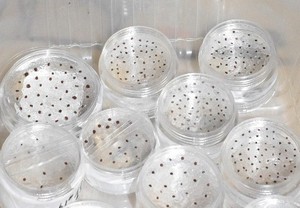 Hydrangea can be grown from seeds at home. Planting of seed material is carried out in a nutrient substrate, which is used during transplantation. Seeds are sown superficially, without sprinkling with soil. This procedure is carried out in winter. Seedlings are covered with transparent polyethylene or glass. Further care behind plantings consists in their periodic airing and moistening by spraying from a spray bottle. The soil should be constantly wet, but not flooded.
Hydrangea can be grown from seeds at home. Planting of seed material is carried out in a nutrient substrate, which is used during transplantation. Seeds are sown superficially, without sprinkling with soil. This procedure is carried out in winter. Seedlings are covered with transparent polyethylene or glass. Further care behind plantings consists in their periodic airing and moistening by spraying from a spray bottle. The soil should be constantly wet, but not flooded.
After the seedlings germinate, the shelter can be removed. Strengthened seedlings with two or three leaves are transplanted into deeper containers with the same soil composition. The next picking is carried out after the young plants grow up and release four to five leaves. Hydrangeas are planted individually in pots with a diameter of seven centimeters.
By dividing the bush
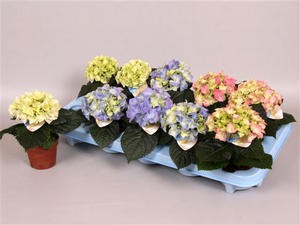 Indoor hydrangea can be propagated in another way - by dividing the rhizome. At home, this procedure is carried out in the spring during flower transplantation, so that by autumn the separated plants have time to take root.
Indoor hydrangea can be propagated in another way - by dividing the rhizome. At home, this procedure is carried out in the spring during flower transplantation, so that by autumn the separated plants have time to take root.
The bush is dug up, then divided into parts so that each division has several points of growth and roots. Before planting, cut the stems and roots in half on each delenka. Plants are planted individually in a nutrient substrate, abundantly moistened and covered with a layer of mulch.
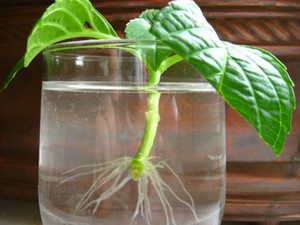 most reliable and effective method propagation of indoor hydrangeas - cuttings. To do this, cut the basal stems with several internodes. The lower part of the shoots is completely freed from leaves. From above, the foliage is cut in half or a third, depending on their size. Then planting material dipped in any growth stimulant for a few minutes and planted in the soil. Best of all, cuttings take root in a peat-sand mixture. The subsequent care of plantings consists in ensuring a stable temperature regime within twenty degrees and an increased level of humidity - about eighty percent. Therefore, planted shoots cover plastic bottle or clear jar. In addition, the cuttings must be periodically moistened, preventing the soil from drying out. If everything is done correctly, then in a month the shoots will take root. After that, they are seated separately in flowerpots with a diameter of seven centimeters.
most reliable and effective method propagation of indoor hydrangeas - cuttings. To do this, cut the basal stems with several internodes. The lower part of the shoots is completely freed from leaves. From above, the foliage is cut in half or a third, depending on their size. Then planting material dipped in any growth stimulant for a few minutes and planted in the soil. Best of all, cuttings take root in a peat-sand mixture. The subsequent care of plantings consists in ensuring a stable temperature regime within twenty degrees and an increased level of humidity - about eighty percent. Therefore, planted shoots cover plastic bottle or clear jar. In addition, the cuttings must be periodically moistened, preventing the soil from drying out. If everything is done correctly, then in a month the shoots will take root. After that, they are seated separately in flowerpots with a diameter of seven centimeters.
Problems in indoor growing hydrangeas
 Indoor hydrangea, like many other flowers at home, can be affected by diseases and pests. Of course, if you properly care for the plant, then there will be no problems.
Indoor hydrangea, like many other flowers at home, can be affected by diseases and pests. Of course, if you properly care for the plant, then there will be no problems.
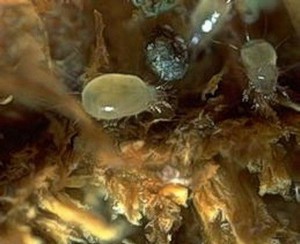
rest period
Competent preparation for winter is one of the main rules for caring for this perennial. The dormant period of room hydrangea is almost three months.
At this time, the plant is taken out to a cool and dark place, its leaves and well-developed stems are shortened, weakened shoots are cut off completely. Preparation of a flower for hibernation begins in December. At the end of February, this plant is returned to its original place, waiting for lush and colorful flowering in the spring.
Indoor hydrangea will not leave anyone indifferent, its extraordinary beauty is amazing, for this reason many gardeners tend to plant it not only on personal plot but also to settle this beautiful flower on a warm windowsill. As home plant It is most common to use large-leaved hydrangea. According to experts given plant can grow up to 1.5 meters in height. Read the hydrangea planting guide.
The flowering period of room hydrangea begins in early spring and lasts until late autumn, but during the period of cold weather, the plant is at rest.
Indoor flower Hydrangea, description and photo
There are two main types of hydrangea:
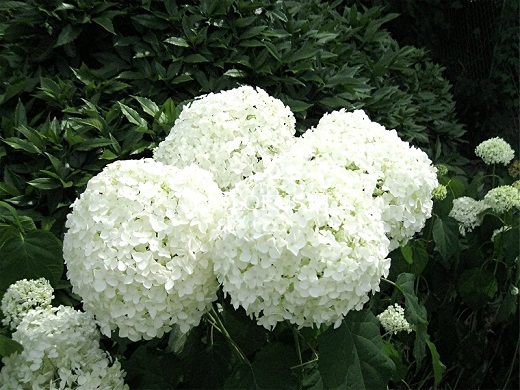
- tree-like - this is a species that is most often planted on a personal plot, but they will also feel quite tolerable in a pot; Hydrangea tree is most like a shrub. She loves light and moisture.
The inflorescences and leaf shape are completely different, because today a huge variety of varieties have been bred, of a wide variety of colors, shapes and sizes. Read about how to care for homemade hydrangea here:. - hydrangea paniculata is a type of hydrangea, which is distinguished by a high pyramidal dense inflorescence, which is located at the end of the branches, the shape of the leaf is from round to sharp peaked. Variety "Darum" is probably the shortest hydrangea that amateur gardeners prefer to grow indoors. Should be given Special attention the place where the indoor hydrangea will be located. Many varieties do not like direct sunlight and even more difficult to tolerate temperature changes.

Hydrangea room, planting and care
Hydrangea is a plant that, regardless of the landing site, requires decent and reverent care. Let's break it down point by point:

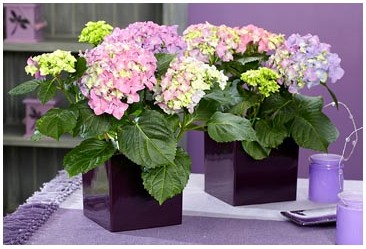
Hydrangea, or hydrangea (Hydrangea) perennial shrub of the Hydrangeaceae family, or hydrangeas (Hydrangeaceae), common in East Asia, North and South America.
The first name of the genus Hortensia was in honor of the French princess Hortensia. And much later, scientists renamed the plant Hydrangia, which comes from the Greek words "hydor" - water and "angeion" - a vessel, which indicates that the plant belongs to moisture-loving. But gardeners all over the world got accustomed to the first name - Hydrangea.

Hydrangeas are perennial, deciduous, large-leaved, ornamental shrubs (sometimes liana-shaped). From uric roots grows up to 5 stems. The leaves are dark green, opposite, elongated-oval, pointed, serrated at the edges, with clearly protruding veins. The flowers are collected in large spherical inflorescences. More often, flowers of two types - small fruiting, located in the middle of the inflorescence and marginal - large, barren, from 4-5 petal-shaped sepals, mostly snow-white, blue or pinkish. The fruit is a 2-5-separate box with numerous small seeds.
Kinds

Large-leaved hydrangea (Hydrangea macrophylla) — ornamental shrub, in open ground the plant can reach 1-2 m in height. Shoots are upright. Leaves numerous, ovate, green. The flowers are collected in large (up to 20 cm in diameter), dense, spherical inflorescences, formed at the ends of the shoots. A potted plant produces 3-6 flower heads. On the acidic soil flowers are blue, on alkaline - pink in various shades, even white.
There are several varieties of large-leaved hydrangea:
- variety Japanese(Hydrangea macrophylla var. Japonica) - with flat inflorescences, along the edges of which there are large sterile flowers, and the middle is occupied by fertile ones.
- variety fickle(Hydrangea macrophylla var. Mutabilis) - spherical inflorescences, consisting of large sterile flowers. Numerous varieties This variety is widely used in industrial floriculture.
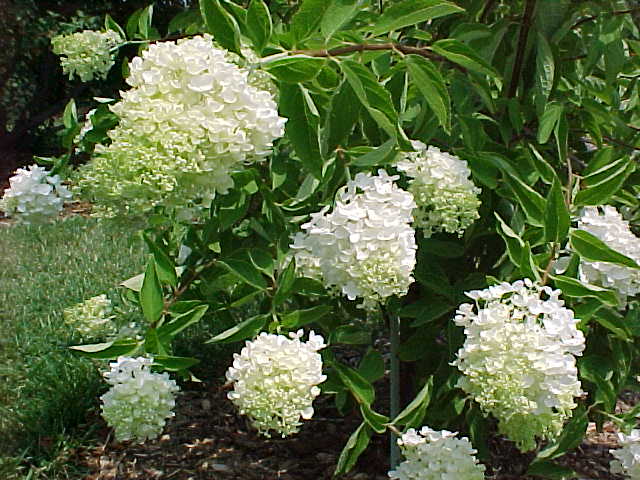
Hydrangea paniculata (Hydrangea paniculata)- shrub or small tree, with large serrated leaves. The flowers are collected in corymbose or paniculate inflorescences and can be white, pink, red, blue and blue. This species is frost-resistant and tolerates temperatures of -15°C; even if the above-ground part of the plant is destroyed by frost, it will grow back as soon as it gets warmer. Requires annual pruning.
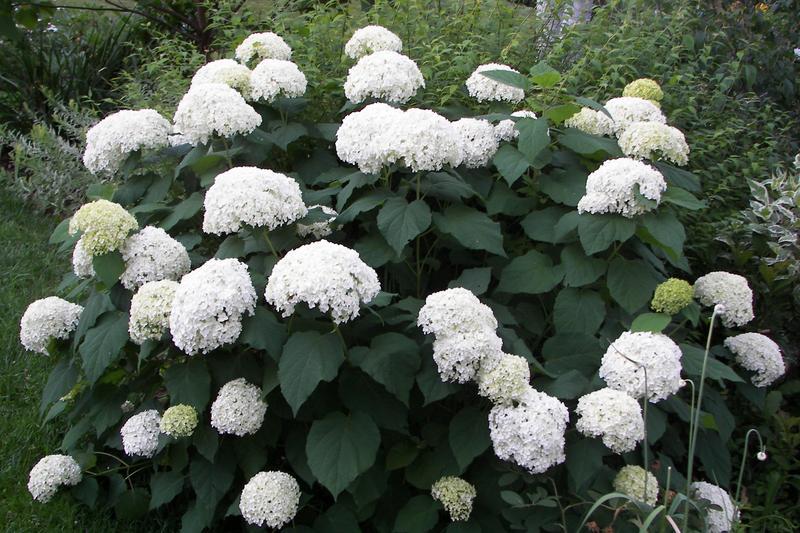
Hydrangea tree (Hydrangea arborescens)- upright shrub, reaching a height of two meters. Flowering begins in July and continues until frost. Inflorescences are large (up to 25-30 cm), densely covering the bushes. Before the start of growth, a short pruning of the bushes is necessary. Frost-resistant plant, tolerates temperatures down to -20°C, quickly recovers in spring.

Hydrangea petiolate, or creeping (Hydrangea scandens, petiolaris)- hardy liana, reaching a height of about 20 m, clinging to the support with numerous aerial roots. The flowers are white, collected in umbellate inflorescences.
Care
![]()
Lighting
During the active growing season, Hydrangea does not tolerate direct sunlight, so it is better to place it in partial shade. But in winter period(from the beginning of January until the formation of buds), on the contrary, it is recommended to place the plants in the most lit, sunny places.

Hydrangea "Avantgarde"
Temperature
In summer, hydrangea is recommended to be taken out on Fresh air, in a cool place. For the winter, the hydrangea sheds its leaves, so it can winter in a dark place at a temperature of 4-8 ° C; at the beginning of spring, it should be moved again to a bright and warm place where the temperature should not exceed 20 ° C. At temperatures above 20°C, the plant sheds its leaves.
Majority garden hydrangeas frost-resistant. They are cut or bent to the ground for the winter, and covered spruce branches. Under such shelter, the plant winters well. If the ground part of the hydrangea freezes, then it can be cut off, and then the plant will bloom next year.
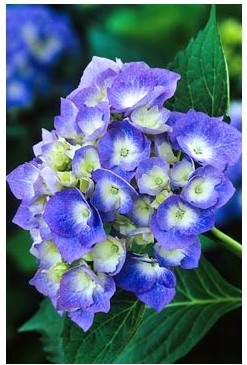
Hydrangea "Holstein"
Air humidity
Hydrangeas prefer high humidity. To do this, it is recommended to regularly spray the leaves, you can place the pot in a tray with wet expanded clay or moss, but the bottom of the pot should not touch the water.
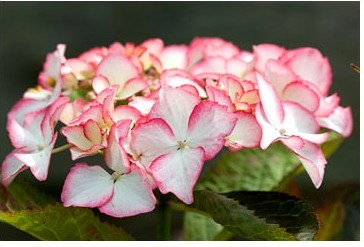
Hydrangea "Love You Kiss"
Watering
In the spring and summer, hydrangea prefers abundant watering, as the topsoil dries out. Since autumn, watering is gradually reduced. In winter, the hydrangea is watered occasionally, but the soil is not allowed to dry out completely. When leaves appear, watering is gradually increased.

Hydrangea "Mousmee"
Fertilizer
With the advent of buds, hydrangeas begin to be fed complex fertilizer for flowering plants 2 times a month.
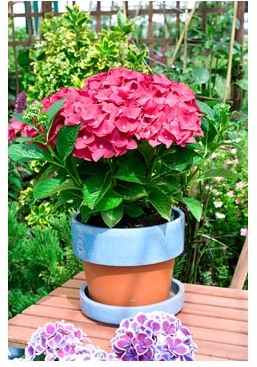
Hydrangea "Red Beauty Violet"
rest period
In winter, hydrangeas have a dormant period. At this time, she sheds her leaves. Store pots at this time should be in dry, cool rooms, you can in the dark. The rest period lasts 2-2.5 months.
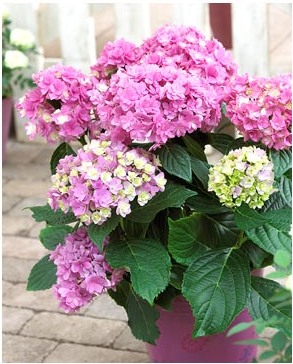
Hydrangea "You And Me Together"
pruning
After a dormant period, it is necessary to prune weak and elongated shoots, leaving 2-6 eyes on the branch. This contributes to a good growth of new, stronger shoots, increased flowering.
![]()
Hydrangea "Yvonne"
Transfer
Hydrangea is transplanted annually. At the same time, one must be careful with the choice of soil, because white, pink and red varieties require soil with low acidity, and blue varieties require high acidity.
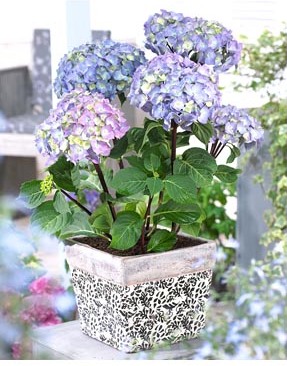
Hydrangea "Zulu"
reproduction
Hydrangeas are propagated mainly cuttings, less often seeds, division of bushes, offspring and layering, grafting.
For cuttings in March, take young lower shoots with leaves 7-8 cm long with 2-3 internodes. Leaf blades are shortened by a third or half. The two lower leaves must be removed, the cut must be straight, 3-4 mm below the node. They are planted at a distance of 4-5 cm from each other in deep bowls, deepening into the sand by 1.5-2 cm. It is not recommended to cover the cuttings with glass, as they can rot. In the first week they are sprayed 3-4 times a day, then 1-2 times. After 5-6 weeks, well-rooted cuttings with a clod of earth are planted in 7-9 cm pots. In May, the cuttings are pinched for bushiness.
Cuttings in March, hydrangeas will bloom in May - June next year. Annual plants form 1-3 inflorescences.
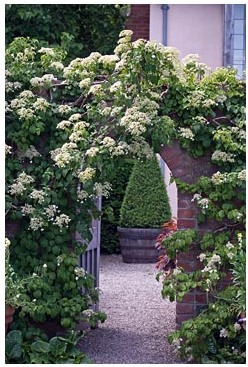
Diseases and pests
Spider mite. It affects the leaves from the underside, causing them to turn yellow and marble, then dry and fall off. The tick covers the underside of the leaf with a brown cobweb.
Preparations for the fight: actara, actellik, fitoverm, thiophos.

Hydrangea "Brugg"
False powdery mildew
. It affects the leaves and stems of hydrangeas. Its first signs are the appearance on the leaves of oily, later turning yellow spots, gradually darkening and increasing in size. A yellowish coating appears below the leaves, the same coating can be on young stems. The development of the disease is facilitated by a temperature of 18-20 ° C and high humidity air.
Control measures: treatment of affected plants with copper soap liquid (150 g of green soap, 15 g blue vitriol per 10 liters of water). This liquid is harmless to plants, and its use in the early stages of development helps to completely get rid of the disease.

Hydrangea "Red Sensation"
Chlorosis. A sign of chlorosis is the lightening of the leaves, only the veins on them remain dark. Plants growing on soils with a significant amount of lime are more susceptible to chlorosis. An excess of humus in the soil also leads to chlorosis.
Control measures: pour 2-3 times with a solution of potassium nitrate at the rate of 40 g per 10 liters of water and three days later - with a solution iron sulphate, also 40 g per 10 liters of water.
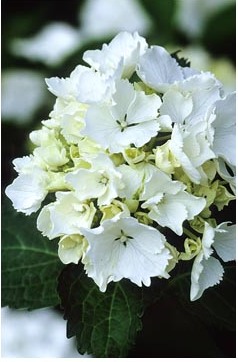
Hydrangea "Nymphe"
In conditions closed ground when forcing plants, hydrangea can be affected green leaf aphid.
Control measures: a good remedy its destruction is a double spraying of plants with a solution of anabazine sulfate. To do this, 15-20 g of anabazine sulfate is dissolved in 10 liters of water.
105 thoughts on Hydrangea - care and reproduction at room conditions”
Hydrangea, charming with white, blue or pink flowers, is able to decorate with itself and breathe comfort into any room.
From spring to autumn, lush hydrangea inflorescences will delight you, while in winter the plant will go to wintering to gain strength for a new flowering. Surprisingly, treat, and even a novice florist will cope with caring for her.
Types and varieties of hydrangeas that are grown indoors
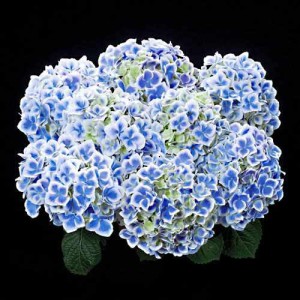 Hydrangea, whose second name is "hydrangia", made up its name from the Greek words for "water" and "barrel", which eloquently declares the plant's love of moisture.
Hydrangea, whose second name is "hydrangia", made up its name from the Greek words for "water" and "barrel", which eloquently declares the plant's love of moisture.
The beautiful hydrangea comes from the distant Azores, where she got used to the sea air.
In order for hydrangeas to be pleasant in your home, you need to provide them with coolness and moisture in sufficient quantities.
The genus of hydrangeas is almost 90 species of plants, among which there are vines, shrubs and trees. But not all of them are cultivated in an apartment.
Large-leaved hydrangea is one of the most beloved species of flower growers., which includes many varieties and has been grown at home since the late 18th century.
The hydrangea has amazing property, due to which the color of its flowers can vary depending on the composition of the soil. For example, if you plant a hydrangea with light green inflorescences in the soil enriched with iron salts, its flowers will turn blue. Very often in the past, for the sake of this effect, flower growers placed iron nails in the ground.
More than 100 varieties have been created on the basis of large-leaved hydrangea, among which there are not only many colors, but even two-color species and plants with color transitions.
AT indoor floriculture popular varieties are:
- with classic white flowers;
- Madame Emily Mulier with pink inflorescences;
- Sister Teresa with sky blue flowers;
- Hamburg with bright pink flowers;
- Goliath with white and blue flowers;
- Europe with beautiful scarlet caps of inflorescences;
- Prima, pleasing to the eye with blue or red flowers;
- Compact with large pink or white inflorescences.
Optimal growing conditions
 So, what are the features of home hydrangea care? The peculiarity of the content of hydrangea is that even in summer, it likes to be cool.
So, what are the features of home hydrangea care? The peculiarity of the content of hydrangea is that even in summer, it likes to be cool.
The optimum temperature for it in summer is 8-18 °C, in winter - 8-10 °C. The temperature should gradually increase with the onset of spring.
Hydrangea does not tolerate drafts and sudden changes in temperature.
Hydrangea does not like direct sunlight. Therefore, the ideal place for it is penumbra. It would also be nice to place it 3-4 meters from the window.
Watering hydrangeas
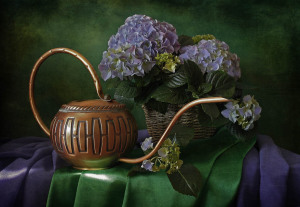 Moisture-loving hydrangea abundant watering required. The best thing water hydrangea boiled, settled, melted or rain water at room temperature. In winter, watering is reduced until the time when the plant begins to pick up buds.
Moisture-loving hydrangea abundant watering required. The best thing water hydrangea boiled, settled, melted or rain water at room temperature. In winter, watering is reduced until the time when the plant begins to pick up buds.
Hydrangea will not refuse from "bathing" when a flower in a pot is placed briefly in water, and then wait until the water has completely drained.
In addition, spraying is one of the favorite hydrangea procedures. Spraying the plant is required all year round . You can not keep the plant near heating appliances.
Healthy periodically water the hydrangea with acidified water(4-5 drops of lemon juice per liter of water), which will help maintain desired acidity soil and protect the plant from yellowing leaves.
Bloom
Hydrangea blooms from April to November with umbellate inflorescences. Each plant has up to 6 inflorescences with a diameter of about 20 cm.
What inflorescences bloom different kinds this is amazing beautiful flower You can watch in the video.
Hydrangea transplant
 Hydrangea prefers to be transplanted every two to three years in a pot, the diameter of which should be 1.5 times the previous one.
Hydrangea prefers to be transplanted every two to three years in a pot, the diameter of which should be 1.5 times the previous one.
The best thing use for landing acidic soil with pH 5.5. An excellent option would be a mixture of peat, coniferous soil, humus and sand.
It is necessary to plant hydrangea in a wide pot, because The roots of this plant grow in breadth. Do not forget about good drainage with a layer of 3 cm at the bottom of the pot.
reproduction
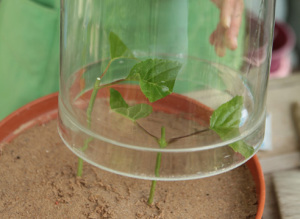 Hydrangea can be propagated by cuttings.
Hydrangea can be propagated by cuttings.
For this, cuttings 7-10 cm long are placed in a container with clean river sand or soil, cover with a jar or plastic wrap. It is necessary to maintain the temperature in the region of 22-25 ° C and wait for the first leaf to appear.
It is best not to cut the cuttings, but to break them off. After planting young hydrangea plants, one should not forget about additional care - pinching the top.
top dressing
feed the hydrangea best integrated mineral fertilizer once a week. In summer, top dressing stimulates plant growth, and in winter it prepares the plant for flowering. The optimal ratio is the proportion of 2 g of fertilizer per liter.
How to prune a hydrangea
When the hydrangea has faded, it is necessary cut off all weak shoots leaving only strong stems. For the formation lush bush cut off and top, which will provoke the growth of side shoots.
Very accessible, in detail and clearly about the process of removing hydrangea shoots after flowering, you can see in the video.
Features of hydrangea care in winter and autumn
Hydrangeas needed cool wintering, which can pass on the windowsill, but only in the absence of a heating battery under it. However better Total place plant to a dark place, for example, in the basement or under the bed. Even so, the plant need to be watered occasionally. But it should be remembered that if you overdo it with watering in winter, the roots of the plant will rot.
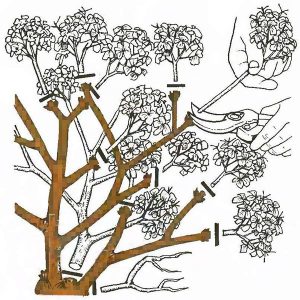 With the onset of the middle of winter and the appearance of the first hydrangea buds need move to a room with more warm air and lots of light, and it is also necessary increase watering.
With the onset of the middle of winter and the appearance of the first hydrangea buds need move to a room with more warm air and lots of light, and it is also necessary increase watering.
When the plant has flowered, cut shoots to half length.
If you skip wintering and keep the hydrangea in a warm place, flowering will come only next winter.
Pests that often disrupt the life of hydrangeas
Aphids, which can be defeated by treatment with soapy water.
Which will disappear if you regularly spray the plant or treat it with actellik.
Stem nematode - unfortunately, the plant cannot be saved, it will have to be thrown away.
Despite its unpretentiousness of room hydrangea, there are some problems when caring for it. Here we present to your attention the most frequent and, most importantly, tips for their elimination:
- Yellowing leaves indicates insufficient soil acidity. If this was confirmed by verification, the situation can be normalize by watering the hydrangea with lemon water(2-3 drops of lemon juice per liter of water).
- Drying of leaf tips or brown spots on the leaves- the plant suffers from too dry air or poor watering. Increased humidity and abundant watering fix the situation.
- Light spots on the leaves- a sign of excess light and direct sunlight. To help the plant move it to shade and protect from direct sunlight.
- Too slow growth occurs due to a lack nutrients, which can replenish with a complex mineral or organic fertilizer.
A magnificent hydrangea that blooms from spring to autumn is wonderful plant, capable of coloring life with bright colors and making the house cozy. Hydrangea care, unpretentious perennial plant, not too troublesome. It is enough to know its main features and from time to time to pay a little attention to it, and it will answer you. lush bloom pleasing to the eye and warming the soul.

